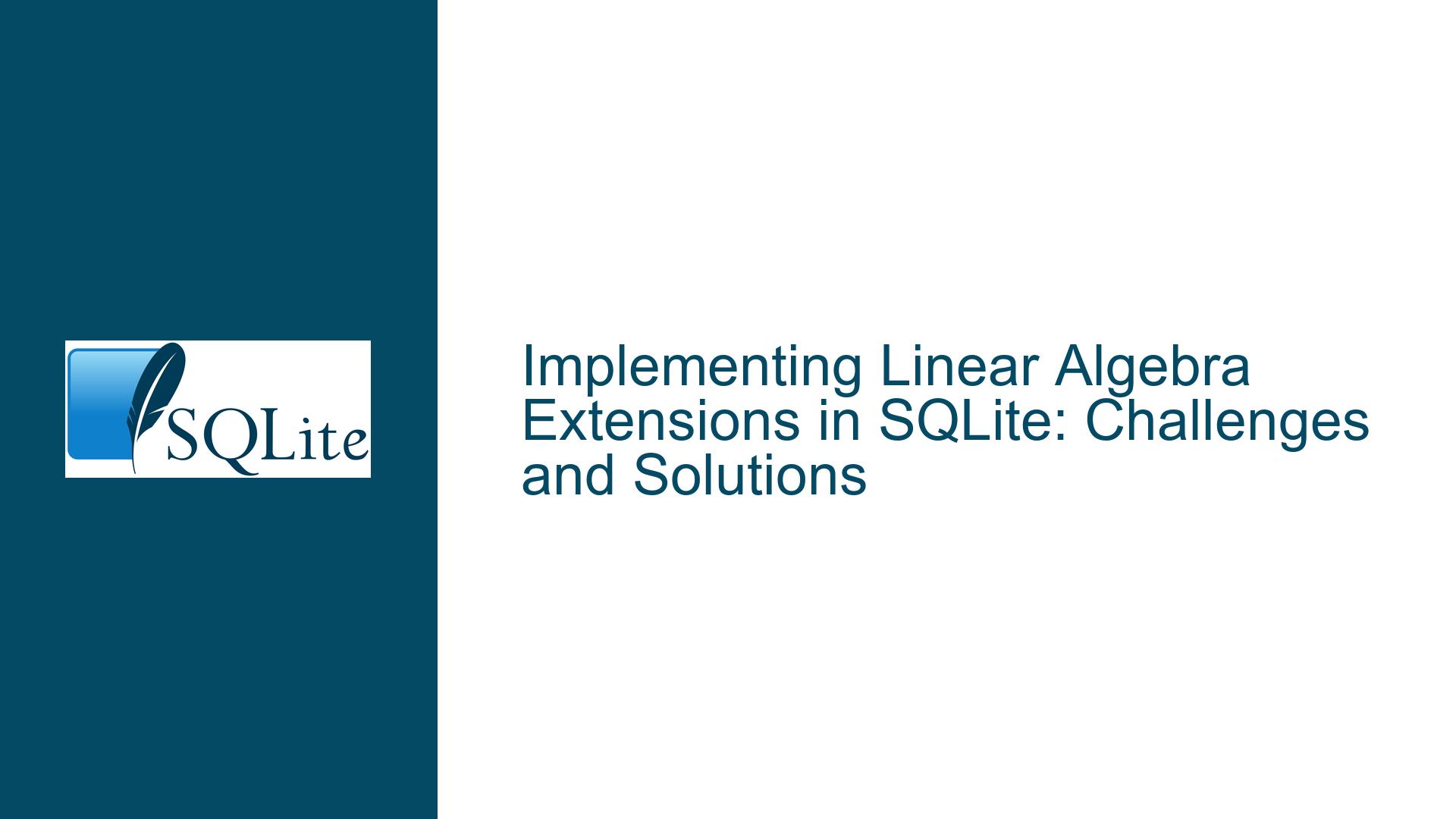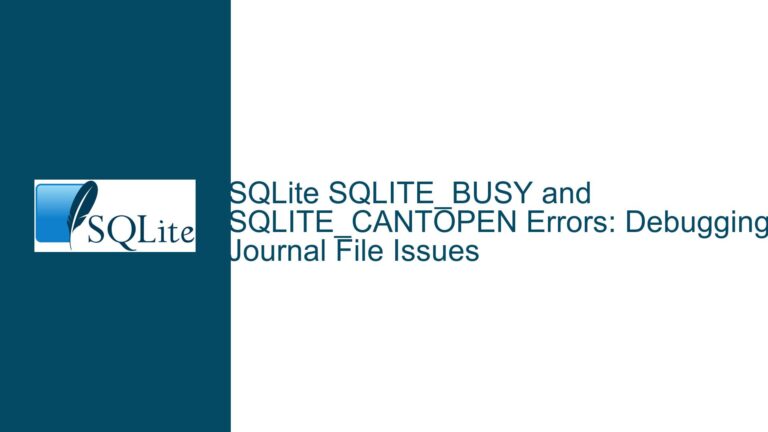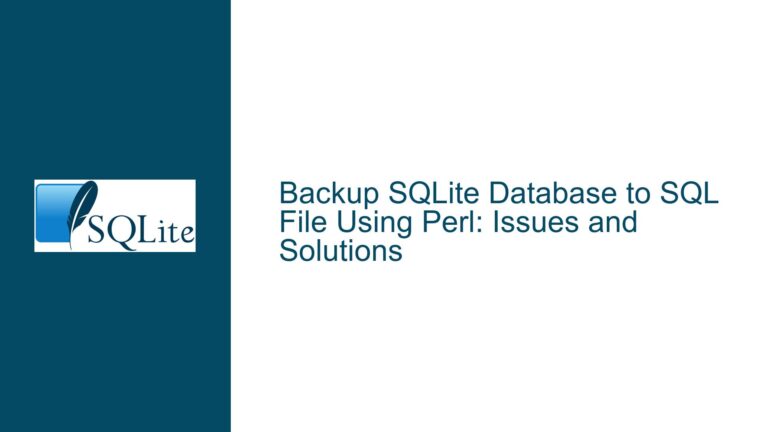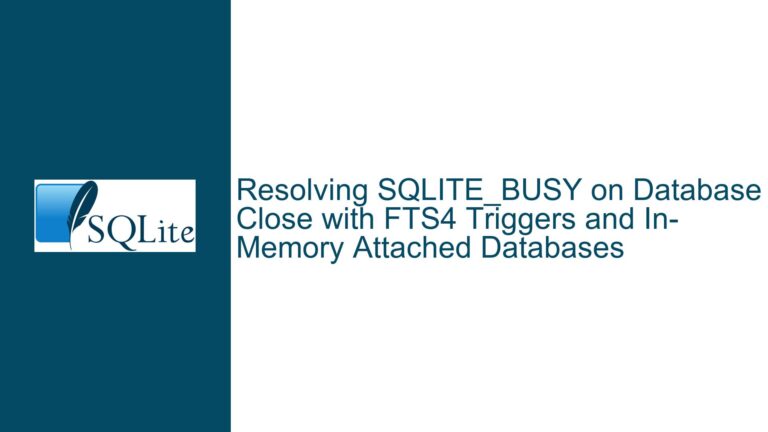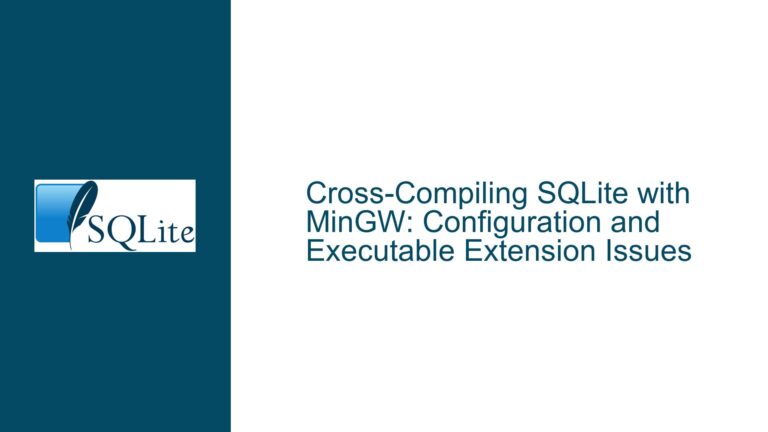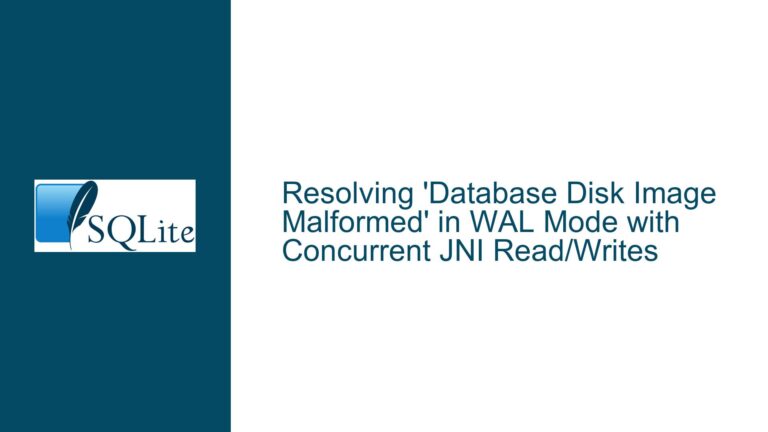Implementing Linear Algebra Extensions in SQLite: Challenges and Solutions
Extending SQLite with Linear Algebra Types and Operations
The idea of extending SQLite to support linear algebra operations directly within the database engine is an ambitious and intriguing proposition. This would involve introducing new data types, such as matrices and vectors, and defining operations like matrix multiplication, eigenvalue computation, and vector dot products. The goal is to create a seamless integration of storage and computation, eliminating the need for data extraction, transformation, and reloading, which is a common bottleneck in data analysis workflows. However, this endeavor is not without its challenges, both from a technical and practical standpoint.
The core issue revolves around the feasibility of implementing such extensions without forking the SQLite core. SQLite is designed to be lightweight and modular, with extensions like R-trees and JSON1 providing additional functionality without modifying the core database engine. However, introducing linear algebra types and operations would likely require deeper integration, potentially necessitating changes to the SQLite core. This raises questions about the complexity of the task, the expertise required, and the potential performance implications.
Feasibility and Complexity of Implementing Linear Algebra Extensions
The feasibility of implementing linear algebra extensions in SQLite depends on several factors, including the level of integration required, the performance expectations, and the expertise of the developer. SQLite’s architecture is designed to be simple and efficient, with a focus on embedded systems and lightweight applications. Introducing complex mathematical operations and new data types would require significant modifications to the core engine, which could compromise its simplicity and performance.
One of the primary challenges is the introduction of new data types, such as matrices and vectors. SQLite currently supports a limited set of data types, including integers, floats, text, and blobs. Adding support for matrices and vectors would require defining new storage formats, indexing mechanisms, and query optimizations. This is a non-trivial task that would require a deep understanding of both SQLite’s internal architecture and linear algebra concepts.
Another challenge is the implementation of linear algebra operations. These operations are computationally intensive and require efficient algorithms to ensure acceptable performance. SQLite’s current execution model is optimized for relational operations, such as joins and aggregations, and may not be well-suited for matrix operations. Implementing these operations would require significant changes to the query execution engine, potentially introducing new execution strategies and optimizations.
The complexity of the task is further compounded by the need to maintain compatibility with existing SQLite features and extensions. Any modifications to the core engine must be carefully designed to avoid breaking existing functionality or introducing new bugs. This requires a thorough understanding of SQLite’s codebase and a rigorous testing process to ensure the stability and reliability of the modified engine.
Alternative Approaches to Integrating Linear Algebra with SQLite
Given the challenges of modifying the SQLite core, several alternative approaches have been proposed to integrate linear algebra functionality with SQLite. These approaches leverage existing features and extensions to achieve similar goals without requiring deep modifications to the core engine.
One approach is to represent matrices and vectors as JSON objects and use SQLite’s JSON1 extension to manipulate them. This approach avoids the need for new data types and allows for flexible storage and querying of matrix data. However, this approach has limitations in terms of performance and functionality. JSON manipulation is inherently slower than native matrix operations, and complex linear algebra operations may be difficult to express using SQLite’s JSON functions.
Another approach is to use user-defined functions (UDFs) to implement linear algebra operations. SQLite allows developers to define custom functions in C, which can be called from SQL queries. This approach provides greater flexibility and performance compared to JSON manipulation, as the UDFs can be optimized for specific operations. However, implementing UDFs for complex linear algebra operations requires a strong understanding of both SQLite’s C API and linear algebra algorithms. Additionally, UDFs are limited in their ability to interact with SQLite’s query execution engine, which may restrict their performance and functionality.
A third approach is to integrate SQLite with an external scripting language, such as Lua or Python, to handle linear algebra operations. This approach leverages the strengths of both SQLite and the scripting language, allowing for efficient data storage and retrieval in SQLite while offloading complex computations to the scripting language. Lua, in particular, is well-suited for this purpose due to its lightweight design and ease of integration with C code. However, this approach introduces additional complexity in terms of managing the interaction between SQLite and the scripting language, and may not provide the seamless integration that is desired.
Detailed Steps for Implementing Linear Algebra Extensions in SQLite
For those determined to implement linear algebra extensions in SQLite, the following steps provide a detailed roadmap for the process. These steps assume a basic understanding of SQLite’s architecture and C programming, and are intended to guide developers through the key stages of the implementation.
Step 1: Define the New Data Types
The first step is to define the new data types for matrices and vectors. This involves specifying the storage format, indexing mechanisms, and query optimizations for these types. The storage format should be designed to minimize memory usage and maximize performance, while the indexing mechanisms should support efficient querying and retrieval of matrix data. Query optimizations should be tailored to the specific requirements of linear algebra operations, such as matrix multiplication and eigenvalue computation.
Step 2: Modify the SQLite Core
Once the new data types have been defined, the next step is to modify the SQLite core to support these types. This involves making changes to the database engine’s internal data structures, query parser, and execution engine. The query parser must be updated to recognize and parse SQL statements involving matrices and vectors, while the execution engine must be modified to handle the new data types and operations. This step requires a deep understanding of SQLite’s codebase and a careful approach to ensure compatibility with existing features.
Step 3: Implement Linear Algebra Operations
With the new data types and core modifications in place, the next step is to implement the linear algebra operations. This involves writing efficient algorithms for matrix multiplication, eigenvalue computation, and other operations, and integrating these algorithms into the SQLite execution engine. The algorithms should be optimized for performance, taking advantage of SQLite’s internal data structures and execution strategies. This step requires a strong understanding of linear algebra and algorithm design, as well as experience with performance optimization.
Step 4: Test and Validate the Implementation
The final step is to test and validate the implementation. This involves creating a comprehensive test suite to verify the correctness and performance of the new data types and operations. The test suite should include a variety of test cases, ranging from simple matrix operations to complex linear algebra computations, and should be designed to identify any potential issues or bugs. The implementation should also be validated against existing linear algebra libraries and tools to ensure compatibility and correctness.
Step 5: Optimize and Refine
Once the implementation has been tested and validated, the final step is to optimize and refine the code. This involves identifying and addressing any performance bottlenecks, refining the algorithms and data structures, and ensuring that the implementation is robust and reliable. The optimization process should be iterative, with continuous testing and refinement to achieve the desired performance and functionality.
Conclusion
Implementing linear algebra extensions in SQLite is a challenging but potentially rewarding endeavor. The process involves defining new data types, modifying the SQLite core, implementing linear algebra operations, and rigorously testing and optimizing the implementation. While the task is complex and requires a deep understanding of both SQLite and linear algebra, the potential benefits of seamless integration of storage and computation make it a worthwhile pursuit for those with the necessary expertise and determination. For those who prefer a less invasive approach, alternative methods such as JSON manipulation, user-defined functions, and external scripting languages offer viable solutions with varying degrees of performance and functionality. Ultimately, the choice of approach depends on the specific requirements and constraints of the project, as well as the expertise and resources available to the developer.
